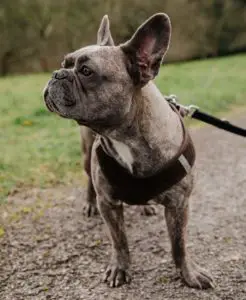French bulldogs are one of the United States’ most popular dog breeds – ranking at number four out of 195. You’ve probably seen these handsome pups are all over Instagram; their compact size makes them great tagalongs on outings and day adventures, and their sweet personalities make them into excellent companions.
These little charmers are small enough that they make fantastic pets for city dwellers, and Frenchies don’t require a lot of outdoor exercise or play space.
French bulldog history is as fascinating as the silly personalities and easygoing temperament of these little dogs, and perhaps most interesting of all is the Frenchie’s rise to fame.
But how did these dogs become so popular? From costumes to memes, Frenchies represent all things cute, as if they were destined for popularity.
It certainly didn’t happen overnight. These beloved dogs appearing all over your Instagram feed have been around for quite a long time, just not in the form you are used to.
Beginning back in the 18th century, French bulldogs had humble roots, compared to their modern popularity. But don’t just take my word for it; let’s take a deep dive into the history of Frenchies.
French Bulldog History Begins in the 18th Century
With the word “French” in the name, you’d expect French bulldogs to have roots in France, right? It’s a fair assumption, but’s a wrong one.
Frenchies first originated in England in the late 18th century. On the cusp of the Industrial Revolution, breeders crossbred bulldogs with smaller dogs, creating the very first variation of French bulldogs.
The French bulldog temperament made them wonderful companions, and they became a favorite pet of many English workers, particularly lace-workers in the Nottingham area.
As the population in England boomed, the necessity for more efficient means of production became absolutely critical. The number of people demanded greater quantities of food and supplies, paving the way for the Industrial Revolution.
And England thrived during the Revolution. Small, rural communities became urban, factory-studded landscapes, and the number of creative individuals living in England at the time led to even more revelations and inventions.
With the success of the Revolution creating stable jobs, more income, and more resources, workers were able to maintain and care for their pets, rather than owning animals for purely agricultural reasons.
But the Industrial Revolution, with all of its efficiency and machine-based work, often put smaller, artisanal individuals and shops out of business. Those lace-makers that so enjoyed their French bulldog companions were out of work in the wake of the Revolution and relocated to Northern France. Those favored canine companions relocated with them.
The popularity of French bulldogs as pets boomed in France. The trendy little dogs were soon in high demand as pets, and English breeders found themselves in a lively niche of trade.
But the English no longer had such a soft spot for Frenchies, so the French inherited the dogs. It was in France that the dogs were bred into the appearance that’s most commonly associated with Frenchies; large eyes, snub nose, and big ears.
Americans traveling to France in the 19th century fell under the Frenchie’s spell, and the dog’s popularity in the United States began.
French Bulldogs Were Bred as Toy Dogs
A Frenchie’s roots lie in a bulldog, but the 18th-century bulldog wasn’t quite what our modern bulldogs look like.
18th-century English bulldogs were strong, athletic dogs who were used in the gruesome activity of “bull-baiting” (thus, the name “bulldog.”) When bull-baiting was outlawed in England, breeders created a toy version of the bulldog, and Frenchies made their first appearance.
Now, these early versions of French bulldogs still weren’t exactly what our modern Frenchies look like.
Crossed with terriers, the traditional snub noses, forehead wrinkles, and so-called “bat ears” weren’t bred into Frenchies until they landed in France, so although these dogs don’t owe their origins to France, it was the French that cultivated the breed into what it is today.
When English lace-makers relocated to Normandy and France, the French were so charmed by their toy bulldogs that they wholeheartedly embraced the little dogs.
Found in the homes of the common workers as well as the bourgeoisie, Frenchies were eventually crossed with terriers and pugs to create smaller French bulldog puppies with the typical, modern characteristics of a Frenchie.
Dogs have long been useful companions to human beings, used to hunt, guard, or protect their families, their animals, or their property. But French bulldogs were some of the earliest dogs that were owned purely for the joy of owning a dog.
In 19th-century France, French bulldogs as pets were just as common among laborers and families as they were among the rich and well-off, when years before, the rich were the only ones that could afford to keep dogs as mere pets.
The French bulldog temperament was highly attractive in its early days, a characteristic that has carried over throughout the years. Their small builds and personalities also made these dogs desirable in 19th-century France.
When Americans took an interest in the dogs, they preferred the bat-eared appearance that’s so popular in Frenchies today. The French preferred what’s called a “rose ear,” meaning that their Frenchies have those big ears that stick up but curve inwards.
Today, bat ears are considered the standard of a purebred French bulldog, and if one of these dogs is to be recognized by the American Kennel Club or participate in dog shows, bat ears are a must.
But regardless of ear shape or preference, the Frenchie solidified its place as one of the United States’ most popular dog breeds for good reason: cuteness, friendliness, and intelligence.
Frenchies Were Originally Bred to be Companions

Compare any dog to a Frenchie and you’ll likely come to a clear conclusion: Frenchies are meant to be charming, pampering-loving little dogs that can be toted on adventures.
Most dogs have origins as swimmers, hunters, herders, ratters, or some other useful characteristic. While bulldogs were originally used in bull-baiting, Frenchies don’t have any brutal origins.
These cute dogs were meant to be companions. Sure, as the English originally bred bulldogs with terriers to create the toy-size of a Frenchie, they did work as ratters for a little while.
But other terrier breeds were able to fill that role quite well, chasing away rats and other nasty vermin from around the house or the barn. There were plenty of other dogs that were small enough to chase rabbits and foxes into burrows, too, so there wasn’t much use for Frenchies.
That didn’t stop people from loving them. And how could these people help it?
French bulldogs are cute, they love their people, they’re fun to dress up, and they’re highly intelligent. Those late 18th-century artisans felt the same way about their little Frenchies as most modern owners do, and it was the belovedness of these dogs that led to their spreading popularity in the early 19th century.
Those English artisans had the right idea in keeping intelligent, lively French bulldogs as their pets, and most modern owners of Frenchies will heartily agree that these dogs are a wonderful asset to their homes.
Dog Shows Rocketed Frenchies to Fame
In 1896, the first Frenchies were shown at the prestigious Westminster Dog Show, despite the American Kennel Club not recognizing the dogs as an official breed.
Presenters showed both rose-eared and bat-eared dogs, but Americans were outraged when the English judge only put up rose-eared dogs. As mentioned, Americans strongly preferred their bat-eared Frenchies. This outrage fueled the founding of the French Bull Dog Club of America.
With the French Bull Dog Club founded, Americans quickly outlined the breed standard of bat ears, but at the 1898 Westminster show, both rose and bat-eared dogs were still shown, despite the newly-inducted standard of bat ears.
The American judge at the Westminster show pulled out, and the French Bull Dog Club successfully launched their own dog show at the Waldorf-Astoria.
The resulting French Bull Dog Club of America after the 1896 Westminster incident was the first-ever canine club dedicated to one specific breed.
And the resulting outrage from Americans was one of the catalysts that launched Frenchies into the realm of popularity.
Before these Westminster incidents, French bulldogs were just a popular type of dog, one that wasn’t actually recognized as an official breed. But Frenchies were so popular that high society ladies entered them into the 1896 Westminster show, thus forcing the American Kennel Club to pay attention to these dogs.
It was 1898 when Frenchies were officially recognized as a breed, and when these dogs’ popularity truly soared. In 2020, French bulldogs tipped the scale of the AKC’s popularity rankings at number four, a jump of two ranking spots since 2016. And in 2010, Frenchies won the Best in Show at the Westminster Dog Show.
The popularity of these dogs will only continue to grow in the future, as well, seeing as they’ve remained a constantly intelligent, personable type of dog.
The Frenchie’s popularity on social media has also helped to continue this dog breed’s popularity, and will likely remain a key component to the French bulldog’s success as the fourth most popular breed in the United States.
Instagram Has Kept the Frenchie Fire Burning
View this post on Instagram❤️❤️❤️❤️❤️❤️ More Frenchie Memes here: https://frenchiejourney.com/favorite-french-bulldog-meme/
A post shared by Frenchie Journey (@journeyfrenchie) on
Much like the Frenchie’s debut at the Westminster dog show in 1896, social media, especially Instagram, has made Frenchies a cute staple of your daily feed. Instagram has become the modern dog show, but allowing its users to experience the best of the best on the daily, instead of just once a year.
With page after page of suggested blogs, Instagrams, and social media accounts to follow, all curated around the cute snub-nosed face of Frenchies, these dogs attract millions of followers, thousands of sponsorships, and an ever-present rise in popularity.
Without the extensive use of social media, French bulldogs may not have turned out to be as popular as they are today. They have a great repertoire of characteristics, but there are hundreds of dog breeds to choose from, not to mention animal shelters.
But Frenchies sit comfortably at rank number four out of 195, and it can definitely be argued that social media has played a huge role in cementing the Frenchie’s status as one of the most popular dog breeds in the United States.
Why are French Bulldogs so Popular?
You could easily answer this question with a few choice words: cute, small, loveable.
But there’s much more to French bulldogs than these surface-grazing words:
1. They’re Adaptable
Frenchies can fit in with a bustling household of children, other pets, and busy adults, or they can be perfectly comfortable in a quiet city apartment with one owner.
These dogs are fairly self-sufficient, and while they can certainly be mischievous, Frenchies are incredibly intelligent and are easily trained.
2. They’re Very Smart

As mentioned, French bulldogs are highly intelligent dogs. They love to explore, whether that’s limited to an apartment in a city or a house in the country.
Frenchies are the type of dog that can be taught how to entertain themselves with the right kind of enforcement and repetition. And honestly, who wouldn’t love watching their dog perform cute tricks?
3. They Have Loads of Personality

Ask any Frenchie owner and they’ll tell you what kind of personality their dog has. French bulldogs are infamous for their grand personalities, from lively to prissy to sweet to mischievous.
Not only are these dogs cute as a button, but their funny antics and charming temperaments are sure to enchant whoever they come across.
Wrapping Up on French Bulldog History
French bulldog history is nuanced with fascinating twists and turns, laying the foundation for the breed’s popularity nearly 200 years ago. From humble roots as a toy version of a bulldog to their Instagram-ruling personas, French bulldogs will only continue to rise in popularity.
So if you find yourself considering a Frenchie, take advantage of our knowledge base for all you need to know before and after adopting your new French bulldog. We’d be thrilled to answer your Frenchie questions, and we’d love to be Frenchie friends!
If you are wondering where to buy a French Bulldog puppy this article will help.



